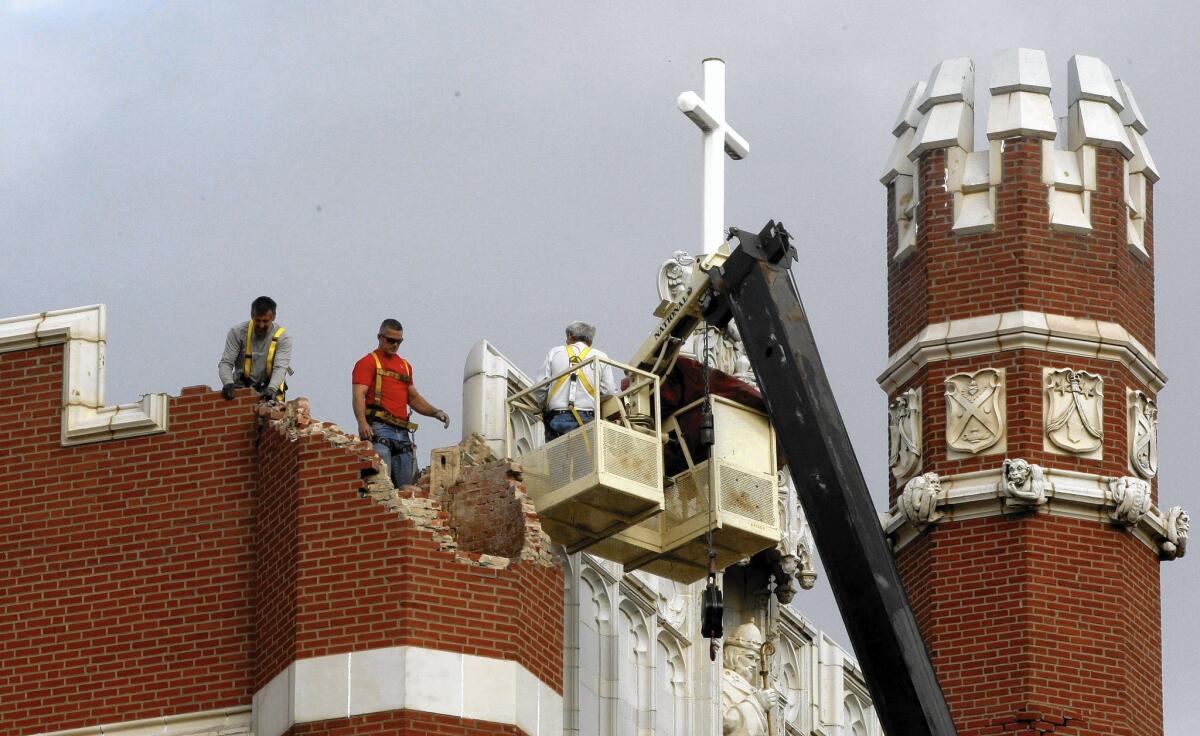Oklahoma takes action on fracking-related earthquakes — but too late, critics say

- Share via
Reporting from OKLAHOMA CITY — They feel them in the little city of Cushing, where a web of pipelines and giant oil storage tanks makes the area a crucial international hub — and vulnerable. They feel them in the time-capsule town of Guthrie, where plaster is cracking in storefronts built in the 19th century. And they feel them in rural Fairview, where cows get loud when pastures move beneath them.
“This last one, I thought the building was coming down,” said Jason Levings, 29, speaking outside the Fairview feed store where he works and which, he was grateful to note, was still standing. “It was intense.”
More than five years after Oklahoma first saw a startling spike in earthquakes linked to the disposal of huge volumes of wastewater created by hydraulic fracturing for oil, the state continues to shake at an unprecedented rate and the number of strong quakes is increasing. In 2009, there were 20 quakes of magnitude 3.0 or higher, according to the United States Geological Survey. Last year, there were 890. In 2009, no quake measured 4.0 or greater. Last year, 30 did.
NEWSLETTER: Get the day’s top headlines from Times Editor Davan Maharaj >>
Yet even as many anxious Oklahomans now track seismic data on their smartphones and struggle to sleep through the long, rumbling nights, there has been one notable location where people rarely seemed rattled. That is here, in the state capital, where the oil industry holds so much sway that for decades drill rigs have extracted crude from directly beneath the Capitol building.
As one Democratic state lawmaker, Cory Williams, put it in an interview: “They own the place.”
Now, however, after quakes have shaken the homes of some top elected officials — and those of the worried constituents who vote for them — the state is taking new steps to address the problem, even as critics say it is too little, too late.
Last month, the Oklahoma Corporation Commission, the agency that regulates the oil and gas industry, asked oil producers operating in the northwest part of the state to reduce the amount of wastewater they are disposing of deep underground by 40%.
Scientists say natural faults in the area are being stirred by billions of gallons of water injected deep into the ground after it is used for hydraulic fracturing, commonly known as fracking. Water and chemicals are used to break oil and gas free from rock formations. A large amount of the water returns to the surface and, under federal law, must be disposed of in a way that does not affect freshwater supplies.
Also last month, the speaker of the Oklahoma state House, Jeff Hickman, a Republican who represents Fairview, sponsored a bill that clarifies that the commission has the power to take enforcement actions — not just to politely ask the industry to change.
And late in January, Gov. Mary Fallin, a Republican who only last summer acknowledged the connection between quakes and oil production, announced that she would direct $1.4 million in emergency funds to the commission and to the Oklahoma Geological Survey to hire new staffers and improve technology and monitoring equipment. (Critics note that, days after making the announcement, the governor did not mention earthquakes in her annual State of the State speech.)
All of it comes as quakes increasingly have been felt in more urban areas, leading to fear, frustration and larger crowds at town hall meetings.
Last week, more than 500 people attended a public meeting on earthquakes at the University of Central Oklahoma in Edmond, with some participants having to watch from an overflow room. The environmental activist Erin Brockovich spoke, as did a Sierra Club official and a lawyer who is building a class-action lawsuit against the oil industry for personal property damage.
The Sierra Club is also suing energy companies on grounds that they are endangering public health and the environment.
“Write your story,” Little-Rock, Ark.-based lawyer Scott Poynter wrote in a letter to people attending the meeting. “Describe the events that you and your family have experienced with the earthquakes. This case will take years, and you will need the story to refresh your memory. Also, it will help me keep everyone’s problems straight.”
Richard Morrissette, a term-limited Democratic state lawmaker not previously known for being active on the issue, announced to the crowd that he planned to run for one of the three commission seats in the fall election. Among his promises: to fight for the repeal of a bill the Republican-controlled Legislature passed last year to prevent local governments from ordering moratoriums on wastewater injection wells.
“The Legislature took away your rights,” said Morrissette, whose district is on the south side of Oklahoma City.
That prompted cheers from a crowd that grew raucous at times. Edmond, where the meeting was held, is one of the wealthiest areas of the state, and many of its residents have become more vocal as quakes have crept closer and grown stronger.
See more of our top stories on Facebook >>
On Feb. 13, a quake northwest of Fairview, about two hours away, registered a magnitude of 5.1, making it the third-strongest quake in the state’s recorded history. The strongest was in 2011. The second-strongest was in 1952; and scientists now say it, too, may have been induced by nearby oil production.
“What’s changed is the earthquakes have come back, and they’ve come back to an area where the people know how to make noise,” said Matt Skinner, a spokesman for the Oklahoma Corporation Commission. “They have the money. They have the power.”
Skinner said he was weary of hearing that the commission is in the pocket of the industry, that it is ignoring science and that it should simply order a moratorium to stop all disposal wells. The first and second are not true and the third would not stand up in court, he said, because of the challenge of directly linking specific disposal actions to specific quakes.
“We have broad correlations but we don’t have specific correlations,” he said.
Skinner emphasized that he and other staff members have suffered damage at their houses from quakes. He said the recent reductions, which critics note depend on voluntary compliance by the industry, have shown the potential to work — but that it may take time.
“There’s going to be a time when we have to go back and say, ‘What did we miss? Why did we miss this?’” he said. “But right now, we’ve got a fire on our hands and we’ve got to put it out.”
Williams, who represents Stillwater, said state officials are overstating the limitations they face and understating their authority. He says the state can order a moratorium, and he wants it to create financial incentives for companies to find safer ways to dispose of wastewater.
“We’re taking some action,” he said of recent moves by the commission and the governor. “But we are taking it three years too late. We have gotten better, but that’s not saying much.”
ALSO
California high court opens door to wrongful foreclosure suits
GOP legislators voting for taxes? It’s not likely to happen again anytime soon
Aerojet gets a big boost in race to develop rocket engine
More to Read
Sign up for Essential California
The most important California stories and recommendations in your inbox every morning.
You may occasionally receive promotional content from the Los Angeles Times.














